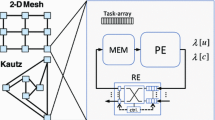Abstract
Network on chip (NoC) has been proposed as an appropriate solution for today’s on-chip communication challenges. Power dissipation has become a key factor in the NoCs because of their shrinking sizes. In this paper, we propose a new encoding approach aimed at power reduction by decreasing the number of switching activities on the buses. This approach assigns the symbols to data word in such a way that the more frequent words are sent by less power consumption. This algorithm dedicates the symbols with less ones to high probability data and uses transition signaling to transmit data. The proposed method, unlike the existing low power encoding, does not rely on spatial redundancy and keeps the width of the bus constant. Experimental evaluations show that our approach reduces the power dissipation up to 46 % with 2.70, 0.51, and 15.43 % power, critical path and area overhead in the NoCs, respectively.













Similar content being viewed by others
Notes
Synopsys and Modelsim are registered trademarks.
References
Marculescu R et al (2009) Outstanding research problems in NoC domain: system, microarchitecture, and circuit perspectives. IEEE Trans Comput-Aided Des Integr Circuits Syst 28(1):3–21
Benini L, De Micheli G (2002) Networks on chip: a new SoC paradigm. IEEE Comput 35(1):70–78
Palma JCS, Indrusiak LS, Moraes FG, Ortiz AG, Glesner M, Reis RAL (2007) Inserting data encoding techniques into NoC-based systems. In: Proceedings of ISVLSI. pp 299–304
Pasricha S, Dutt N (2008) Trends in emerging on-chip interconnect technologies. IPSJ Trans Syst LSI Des Methodol 1:2–17
Postman J, Krishna T, Edmonds C, Peh L, Chiang P (2013) SWIFT: A low-power network-on-chip implementing the token flow control router architecture with swing-reduced interconnects. IEEE Trans VLSI 21(8):1432–1446
Reehal G, Ismail M (2014) A systematic design methodology for low-power NoCs. IEEE Trans VLSI 22(12):2585–2595
Kulkarni M, Agrawal V (2011) Energy source lifetime optimization for a digital system through power management. In: 43rd Southeastern symposium on system theory, pp 73–78
Svensson C (2001) Optimum voltage swing on on-chip and off-chip interconnect. IEEE J Solid-State Circuits 36(7):1108–1112
Wei L, Chen Z, Johnson M, Roy K, De V (1999) Design and optimization of dual-threshold circuits for low voltage low power applications. IEEE Trans VLSI 7(1):6–24
Shin D, Kim W, Kwon S, Han TH (2011) Communication-aware VFI partitioning for GALS-based networks-on-chip. Des Autom Embed Syst 15(2):89–109
Moyer B (2001) Low power design for embedded processors. Proc IEEE 89(11):1576–1587
Snowdon DC, Ruocco S, Heiser G (2005) Power management and dynamic voltage scaling: Myths and facts. In: Proceedings of the workshop on power aware real-time computing, pp 1–7
Benini L, Bogliolo A, De Micheli G (2000) A survey of design techniques for system level dynamic power management. IEEE Trans VLSI 8(3):299–316
Arelakis A, Stenstrom P (2014) SC2: a statistical compression cache scheme. In: Proceedings of the 41st annual international symposium on computer architecture
Anagnostopoulos I, Bartzas A, Filippopoulos I, Soudris D (2012) High-level customization framework for application-specific NoC architectures. Des Autom Embed Syst 16(4):339–361
Palesi M, Ascia G, Fazzino F, Catania V (2011) Data encoding schemes in network on chip. IEEE Trans Comput-Aided Des Integr Circuits Syst 30(5):774–786
Stan MR, Burleson WR (1994) Limited-weight codes for low power I/O. In: International workshop on low power design, pp 209–214
Stan MR, Burleson WP (1995) Bus-Invert coding for low- power I/O. IEEE Trans VLSI 3:49–59
Kim KW, Baek KH, Shanbhag N, Liu CL, Kang S (2000) Coupling driven signal encoding scheme for low power interface design. In: Proceedings of ICCAD, pp 318–321
Benini L, De Micheli G, Macii E, Poncino M, Quer S (1997) System level power optimization of special purpose applications: the Beach solution. In: Proceedings of international symposium on low power electronics and design, Monterey, pp 24–29
Taassori M, Hessabi S (2009) Low power encoding in NOCs based on coupling transition avoidance. In: Proceedings of DSD conferences, pp 247–254
Mamidipaka MN, Hirschberg DS, Dutt ND (2003) Adaptive low power address encoding techniques using self-organizing lists. IEEE Trans VLSI 11(5):827–834
Cheng WC, Pedram M (2002) Power-optimal encoding for a DRAM address bus. IEEE Trans VLSI 10(2):109–118
Lee K, Lee SJ (2004) SILENT: serialized low energy transmission coding for on-chip interconnection networks. In: ICCAD, pp 448–451
Benini L, Macii A, Macii E, Poncino M, Scarsi R (2000) Architectures and synthesis algorithms for power-efficient bus interfaces. IEEE Trans Comput-Aided Des Integr Circuits Syst 19(9):969–980
Lv T, Henkel J, Lekates H, Wolf W (2003) A dictionary based en/decoder scheme for low power data buses. IEEE Trans VLSI 11(5):943–951
Brahmbhatt AR, Zhang J, Wu Q, Qiu Q (2006) Low power bus encoding using adaptive hybrid algorithm. In: Design Automation Conference (DAC), pp 987–990
Benini L, De Micheli G (2006) Networks on chips: technology and tools. murgan kufmann publishers, Burlington
Jafarzadeh N, Palesi M, Khademzadeh A, Afzali-Kusha A (2014) Data encoding techniques for reducing energy consumption in network-on-chip. IEEE Trans VLSI 22(3):675–685
Jafarzadeh N, Palesi M, Eskandari S, Hessabi S, Afzali-Kusha A (2015) Low energy yet reliable data communication scheme for network on chip. IEEE Trans Comput-Aided Des Integr Circuits Syst. 34(12):1892–1904
Vitkovski R, Haukilahti A, Jantsch, Nilsson E (2004) Low-power and error coding for network-on-chip traffic. In: Proceedings of norchip, pp 20–23
Hale KC, Grot B, Keckler SW (2009) Segment gating for static energy reduction in networks-on-chip. In: Proceedings of network on chip architectures, pp 57–62
Raghunathant V, Srivastavat MB, Guptai RK (2003) A survey of techniques for energy efficient on-chip communication. In: Proceedings of design automation conference, pp 900–905
International Technology Roadmap for Semiconductors (ITRS), (2011) Available: http://www.itrs.net
Acknowledgments
The authors are indebted to Dr. Dara Rahmati because of letting us use Persian tool as a NoC infrastructure as well as editors and the referees of the journal for their constructive comments that improved the quality of this paper.
Author information
Authors and Affiliations
Corresponding author
Rights and permissions
About this article
Cite this article
Taassori, M., Taassori, M. & Uysal, S. MFLP: a low power encoding for on chip networks. Des Autom Embed Syst 20, 191–210 (2016). https://doi.org/10.1007/s10617-015-9170-0
Received:
Accepted:
Published:
Issue Date:
DOI: https://doi.org/10.1007/s10617-015-9170-0




